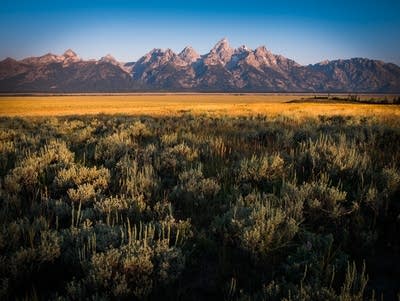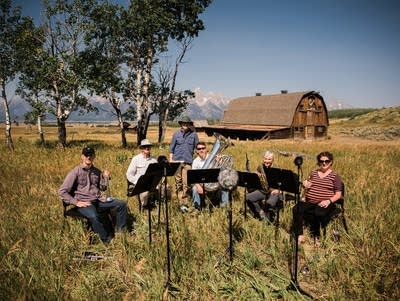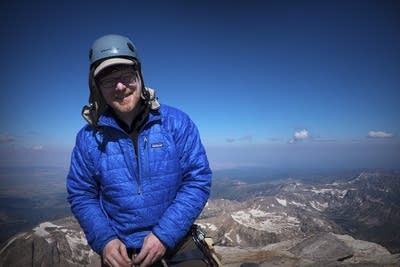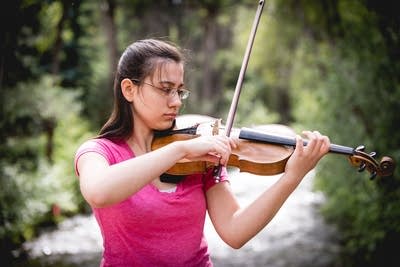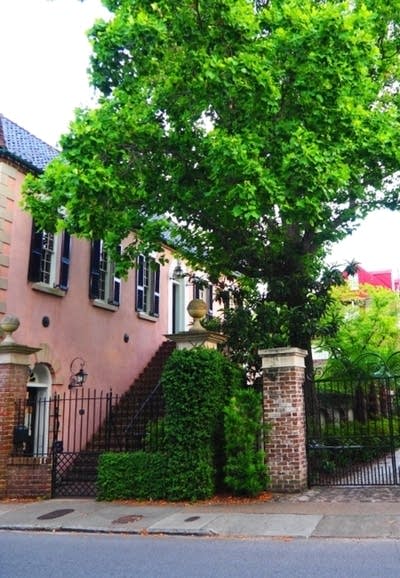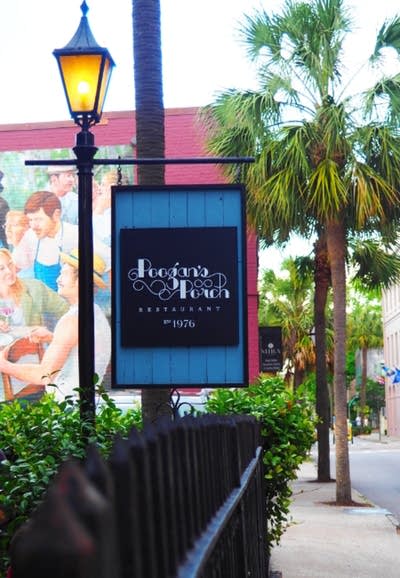For the past few years, the Grand Teton Music Festival has invited Performance Today to host a night of music. To be nestled in the Tetons, cozying up to moose and bears, all with some of the best musicians in the world... how could we refuse? Listen for highlights from our night at the festival, and while you're here, take in some of the breathtaking sights this magical place has to offer.
GTMF Day 1: Fairy Tales from the principal's office
Fred is joined on stage by Gregory Raden (principal clarinet with the Dallas Symphony), Brant Bayless (pricipal viola with the Utah Symphony), and Scott Holshouser (principal piano with the Houston Symphony). The trio joined forces to play a set of music by Robert Schumann based on fairy tales that don't actually exist.
Lia Kass: Paintings inspired by the 2016 Grand Teton Music Festival
As we stood shivering, waiting for the sun to rise in a meadow of sage and fading wildflowers, the Teton mountain range spread out in cinematic beauty to the west. Not once - not a single time - did the sight of those mountains fail to leave us in a state of awe. It must be impossible to live within view of the Tetons and actually get any work done.
Now repeat that special magic 411 more times, and you get the crown jewel of the Department of the Interior: the National Park Service. There's not a majestic mountain range that glows in the morning sun in all 412 parks, but each has its own, set of unique, amazing qualities.
The National Park Service was signed into existence 100 years ago - August 25, 1916, by President Woodrow Wilson. Join us as we celebrate the centennial on PT.
Every day you get to spend in a national park is special. Same goes for live music -- concerts have the ability to take us places we never knew existed. So why not combine these two transcendent experiences?
A brass quintet made up of members from the Grand Teton Festival Orchestra were game to pack up their instruments and join us on location in Grand Teton National Park.
John Stevens: Seasons II. Summer III. Autumn
Tom Hooten, trumpet and flugelhorn; Jennifer Marotta, trumpet and flugelhorn; Gail Williams, French horn; Michael Mulcahy, trombone; Craig Knox, tuba
Performance Today visited the Grand Canyon Music Festival, where high school students from nearby reservations learn to speak their minds through the voice a string quartet.
Voices That Need to be Heard
Nate Ryan/APM
Recently, PT was on location at the 2015 Grand Teton Music Festival for 'A Night with Performance Today.' Listen to live music and conversation from that event, including on stage performances of a trio by Alexander Zemlinsky and music for brass ensemble by Bruce Broughton.
On stage with Thomas LeGrand, David Garrett, and Scott Holshouser
Hints of opera float through this piece by Alexander Zemlinsky. David Garrett plays cello with the Los Angeles Philharmonic; however, he's an alum of the Houston Symphony. Pairing him with current Houston Symphony clarinetist Thomas LeGrand and pianist Scott Holshouser was a mini-family reunion. Time and again musicians kept telling Fred about their long-lasting friendships that were either fostered or kept alive thanks to the Grand Teton Music Festival.
On stage with a boisterous brass ensemble
Conductor, and trombone player, Michael Mulcahy calls this Bruce Broughton piece "quintessential American music." The 17-member brass and percussion ensemble brought the house down with its rendition, which includes a flugelhorn, contrabass trombone and four mallet-wielding musicians making mad dashes to various drum and percussion stations.
Recently, PT was on location at the 2015 Grand Teton Music Festival for 'A Night with Performance Today.' Listen to live music and conversation from that event, including on stage performances of Douglas Hill's Bass 'n' Brass Trio and Robert Schumann's Three Fantasy Pieces.
On stage with Joel Noyes and Donald Runnicles
Normally, when you talk about Donald Runnicles and his involvement in the Grand Teton Music Festival, it's because he is the festival's artistic director. For this performance, Maestro Runnicles stepped of the podium to play piano and chat with Fred about his 9th year as artistic director. Cellist Joel Noyes shared the stage and talked about what it's like playing music with the "boss."
On stage with Gail Williams, Larry Zalkind, and Andrew Raciti
Bass, trombone, horn, and a bunch of percussion - that's what's required of this Douglas Hall composition. And in the hands of these Grand Teton Music Festival veterans, this Latin jazz-influenced piece definitely comes to life. Listen to Fred chat with the trio about how this piece came together, and their new-found respect for their fellow musicians in the percussion section.
On stage with the Jupiter String Quartet
Ten years ago, the members of the Jupiter String Quartet were students at Aspen, playing Ultimate Frisbee and hiking in the woods between intense rehearsals.
This year, the Jupiter String Quartet came back to the Aspen Music Festival and School to coach young quartets and to find a little time for the outdoors in between concerts. Listen to their performance and conversation with Fred Child at Harris Hall in Aspen.
On stage with Alisa Weilerstein
Cellist Alisa Weilerstein doesn't remember her first trip to Aspen -- but not because it was forgettable. It's simply not possible to take memories from your infancy with you into adulthood.
In this conversation with PT host Fred Child, Weilerstein discusses the moments and obstacles that shaped her as a musician. She also performs a tango improvisation by Osvaldo Golijov, which had the entire audience imagining a walk down the cobbled streets of Buenos Aires.
On stage with Joyce Yang in Aspen
Ever since pianist Joyce Yang won the silver medal at the Van Cliburn International Piano Competition, she has been wowing the music world with her artistry, technique and her creativity.
She joins PT host Fred Child on stage at the Aspen Music Festival and School to talk about an unusual piece that has her playing the black keys with her left hand and the white keys with her right hand. When they come together, it sparks a great musical chemistry.
On stage with a stand-out student trio in Aspen
Flutist Emma Gerstein, violist Sofia Nikas and harpist Katherine Siochi met just four weeks ago as orchestral students. They didn't expect to be assigned to play chamber music together at the Aspen Music Festival and School.
After hours of rehearsals and a little bit of musical bonding, these three student have gelled into a polished trio. They joined Fred Child on stage to play the Trio Sonata by Claude Debussy.
If it's somewhere between 11:00 p.m. and 2:00 a.m. during the school year, chances of finding 17-year-old Cynthia Phillipi practicing her viola in her room are pretty good. Phillippi says that even before she was born, her mother would take her to concerts and Broadway shows. You could almost say that music was part of her DNA from the start..
At age three, Phillippi began on piano. Then at age seven, every child in her second grade class was required to take violin. By the time she got to 7th grade, violin won out over piano, and it's been strings ever since. One of her violin teachers noticed that she really gravitated towards the lower register of the instrument.
Voila...a violist was born.
Phillippi's practice regime doesn't slack off in summer, but she does give herself more freedom. At the Aspen Music Festival and School, Phillippi says she's been given a lot of freedom. That's great for running scales, but it's also great for getting outdoors.
Even with a small-ish dose of arachnophobia, Phillippi is taking advantage of the wonderful hiking trails Aspen has to offer. Those walks are sure to fill her memory bank as she heads off to the Curtis Institute of Music this fall to further her studies.
When Lucie Ticho first came to Aspen, she remembers thinking she was way out of her league. Two years later, she's still wowed by her fellow cellists, but the 17-year-old can definitely hold her own.
Ticho feels at home in the hills of Aspen. The first summer she came, she would gaze at the top of Shadow Mountain, which overlooks the student dorms. Atop its peak is a flag, which Ticho wanted to touch. She climbed up the next year, and without a clear path, she achieved her goal. This kind of self-determination is evident in her confident playing as well.
Busking for a little spending money and gigantic slice of pizza is on the docket for most students at the Aspen Music Festival and School. Ticho, who is fascinated by all things French, especially enjoys playing near the local creperie. The tips are nice, and there might even be a free crepe thrown in as a bonus.
Kebra-Seyoun Charles is a 17-year-old Miami native who grew up with rhythm. Some of his earliest memories are of his mother taking him to her African dance and drum performances. And even though he's only four years into playing double bass, he credits those years as being essential to his understanding of music.
Charles has spent the past three summers at the Aspen Music Festival and School. When he's not in class or busking on the streets of downtown Aspen, he likes to take his mind off music by working in the community garden. And when the midday Aspen sun gets to be a bit too much, there's hammock strung low between two, shady trees.
A perk of being a student at the school is free entry into music festival events. Charles caught a recent concert featuring Wynton Marsalis leading the Lincoln Center Jazz Orchestra. A few months earlier, Marsalis judged a competition where Charles' jazz combo performed, and the trumpeter remembered Charles. Not only was Marsalis nice enough to chat with the Charles, but he gave the teen his cell number. Let's be clear, it's not every day the one of the most respected music authorities in the world hands out his number. The sounds and rhythms of Kebra-Seyoun Charles' bass should be with us for years to come.
Every spring, Charleston, SC, is host to the Spoleto Festival USA, a diverse arts and culture festival featuring nationally and internationally renowned artists of every discipline.
And every year, we look forward to featuring highlights from the Spoleto Festival USA on Performance Today. This year, however, we decided to do something special.
Join us all this week for a virtual tour of charming Charleston, as we feature the sights and sounds of the Holy City alongside musical highlights from the Spoleto Festival USA.
Wednesday, June 5: Fort Sumter
Fort Sumter National Monument is located in Charleston Harbor, just off the coast of Charleston, SC.
The fort initially functioned as a Federal garrison, and its close proximity to the Confederate state of South Carolina led to mounting tension between the Union and the Confederacy.
These simmering tensions eventually came to a boil, and in the early morning hours of April 12, 1861, Confederate artillery opened fire on Fort Sumter. With those shots, the tragedy of the American Civil War began.
For the next four years the country was engaged in brutal warfare. By the time the Civil War was officially ended on May 9, 1865, over 700,000 Americans had lost their lives.
Tim Stone is the Park Superintendent of Fort Sumter National Monument and Charles Pinckney National Historical Site. He joined us to discuss Fort Sumter's historical significance, the power of the daily flag raising ceremony, and what he hopes visitors experience when they come to the fort.
Want to experience more Charleston? Click on to read Part 1, Part 2, Part 3, and Part 4 of our exploration of the city.
The Historic Dock Street Theatre is a beautiful performance venue located in the French Quarter of downtown Charleston, SC.
The theatre serves as a performance space for a variety of arts and cultural institutions, including the Spoleto Festival USA.
We toured the theatre with Managing Director Christopher Parham, who spoke with us about the history of the space, its ghostly inhabitants, and the building's recent renovations.
Every spring, Charleston, SC, is host to the Spoleto Festival USA, a diverse arts and culture festival featuring nationally and internationally renowned artists of every discipline.
And every year, we look forward to featuring highlights from the Spoleto Festival USA on Performance Today. This year, however, we decided to do something special.
Join us all this week for a virtual tour of charming Charleston, as we feature the sights and sounds of the Holy City alongside musical highlights from the Spoleto Festival USA.
Wednesday, June 3: Cabbage Row
SCETV director and producer Kate McKinney joined us at Charleston's famous Cabbage Row to talk about its special history.
Cabbage Row was author DuBose Heyward's inspiration for Catfish Row, the setting of his best-known novel, "Porgy." A stage version of the novel later served as George Gershwin's libretto for the opera Porgy and Bess.
McKinney discussed this popular American opera, and told us more about what it's really like in the South in the "Summertime."
Want more Charleston? Click on to read Part 1, Part 2, and Part 3, of our exploration of the city.
Every spring, Charleston, SC, is host to the Spoleto Festival USA, a diverse arts and culture festival featuring nationally and internationally renowned artists of every discipline.
And every year, we look forward to featuring highlights from the Spoleto Festival USA on Performance Today. This year, however, we decided to do something special.
Join us all this week for a virtual tour of charming Charleston, as we feature the sights and sounds of the Holy City alongside musical highlights from the Spoleto Festival USA.
Wednesday, June 3: Pirate Tour
Tour guide (and self-proclaimed Sandlapper) Eric Lavender spoke with us about Charleston's complicated relationship with pirates -- both buccaneers and privateers.
Plus, Lavender discussed what it's like to give tours in full pirate gear with his handsome companion -- a blue and yellow macaw by the name of Captain Bob.
Our thanks to Charleston Pirate Tours and guide Eric Lavender.
Want to experience more Charleston? Click on to read Part 1 and Part 2 of our exploration of the city.
Every spring, Charleston, SC, is host to the Spoleto Festival USA, a diverse arts and culture festival featuring nationally and internationally renowned artists of every discipline.
And every year, we look forward to featuring highlights from the Spoleto Festival USA on Performance Today. This year, however, we decided to do something special.
Join us all this week for a virtual tour of charming Charleston, as we feature the sights and sounds of the Holy City alongside musical highlights from the Spoleto Festival USA.
Tuesday, June 2: Charleston by Carriage
Charleston is a historian's delight. Impressively tall church spires loom over streets lined with a colorful mix of historic homes and buildings, and everywhere lush greenery and flowers bloom in the warm, humid climate. And with a history dating back before the Revolutionary War, there are plenty of historically significant and just plain interesting things to see around town.
One of the best ways to absorb the flavor and history of the city is to take a carriage tour through old Charleston. And that's exactly what we did!
To learn more about historic Charleston and the impact of the Spoleto festival, we spoke with Janice Elkins, a tour guide with Old South Carriage Co.
Want to experience more Charleston? Part 1 of our exploration of the city can be found here.
Every spring, Charleston, SC, is host to the Spoleto Festival USA, a diverse arts and culture festival featuring nationally and internationally renowned artists of every discipline.
And every year, we look forward to featuring highlights from the Spoleto Festival USA on Performance Today. This year, however, we decided to do something special.
Join us all this week for a virtual tour of charming Charleston, as we feature the sights and sounds of the Holy City alongside musical highlights from the Spoleto Festival USA.
Monday, June 1: Poogan's Porch
Charleston is well-known for its cuisine; a combination of classic low country cooking, Southern staples, and a wealth of diverse, eclectic fare.
One of the oldest and best-known restaurants in the city is Poogan's Porch, which is located in a picturesque Victorian townhouse in historic Charleston. In addition to delicious food, Poogan's is home to numerous mysteries: Who was Poogan? Is it true that he haunts the halls of the restaurant? And what on earth is in their amazing buttermilk biscuits*?
To find out more about this iconic Charleston establishment, we spoke with server Justin Zimmerman, who answered these questions and more.
*We were able to solve the mystery of the buttermilk biscuits too. You can find the exact recipe for Poogan's world-renowned biscuits here.
